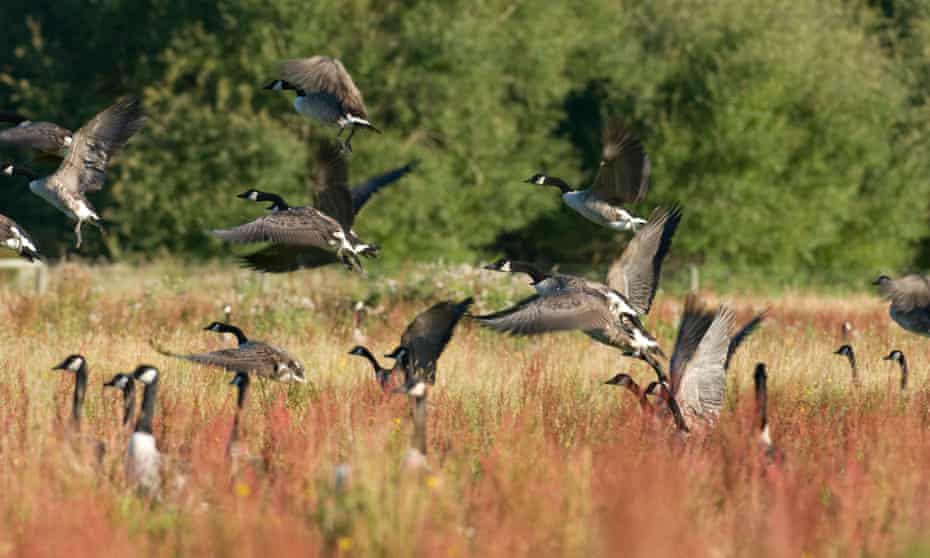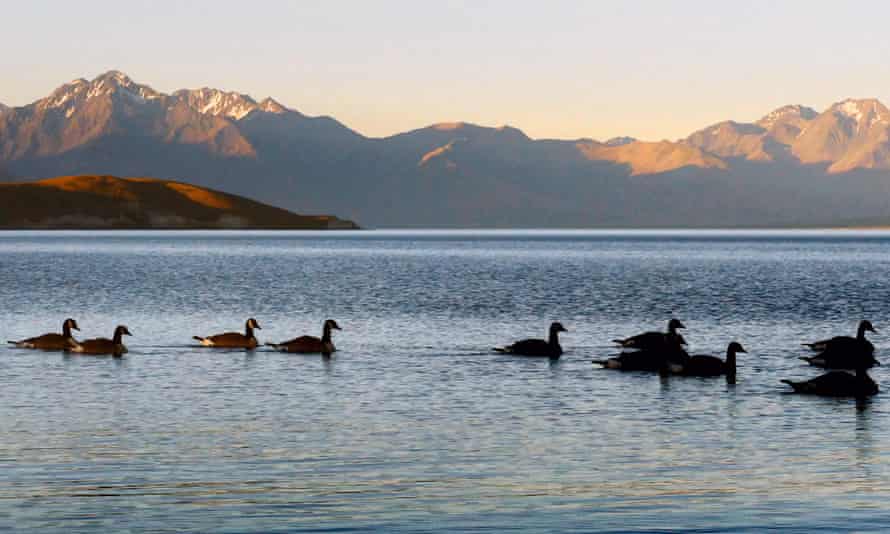‘The rabbit of the sky’: flocks of Canada geese plague New Zealand countryside

The birds exist in a pest-control grey area, with no agency taking the lead, allowing the population to boom
They are aggressive, territorial, noisy and excrete more than a kilogram of faeces a day. Now huge flocks of Canada geese have made parts of rural New Zealand their home, bringing havoc in their wake.
The introduced birds are polluting waterways, damaging pasture and are so numerous in some places that they pose a threat to aircrafts, but little is being done to curb the problem.
But the birds exist in a pest-control grey area, with no agency responsible for them, a problem that is allowing the population to boom. As their numbers grow, so does the damage they cause, and the expense of culling them.
Their faeces can introduce nitrates, phosphorous, e-coli, campylobacter and other bacteria into waterways, damaging the health of shellfish. The voracious eaters cause headaches for farmers – four geese can eat the equivalent amount of grass to one sheep – and their droppings contaminate the soil. In urban areas, they congregate at popular swimming spots, sports areas and parks, posing health and safety risks to the people who frequent them.
Canada geese, which are native to the arctic and Northern America, were introduced to New Zealand’s South Island for hunting in 1905. Up until 2011, they were designated an elite game bird under the Wildlife Act, which gave Fish and Game councils the authority to kill, and cull, the birds.

But in the lead-up to 2011, farmers felt that not enough was being done to control the population, which was consistently about 35,000 birds over 15 years. Farmers lobbied the government to have the designation changed so they could manage birds on their own properties. The then-conservation minister, Kate Wilkinson, obliged and the new status put the birds in the same bracket as sparrows and pigeons, stripping Fish and Game councils of their authority to manage the species, and scrapping requirements for a shooting permit. The change shifted management of the species to farmers, to be coordinated with the Department of Conservation.
It became open season, but farmers and the newly minted hunters faced a problem – the clever birds are difficult and expensive to hunt.
If their nests come under threat, they move into safer, harder-to-reach habitats. To shoot them in flight requires practice, skill and preferably a helicopter, so culls are often carried out during their moult, when they lose their feathers and become flightless for a short period of time. That window sits between Christmas and New Year. Not only are hunters not as readily available, but summer holidaymakers frequent the waterholes where the birds roost and graze, making it harder for hunters to safely go about their business.
The change to the bird’s status “changed the whole way they were managed”, Fish and Game’s Ben Wilson said.
“When populations were getting out of hand, we would have an organised cull, which was very popular. That was all done at the expense of game-bird hunters.
“When we lost status, they had no status at all, and anyone could take a potshot, and that becomes dangerous for game-bird hunters. When you have a decoy and are trying to hide and someone is taking shots at you, it discourages people.”
There is no longer centralised data about the nationwide population – that halted when Fish and Game were stripped of their authority – but Wilson said that in the central North Island “the numbers are going through the roof”.
Fish and Game’s most recent swan and waterfowl count for that region showed the Canada geese population had increased roughly six times in 10 years, with at least 12,000 birds now living near the Waikato lakes, Wilson said.
‘No quick fix’
The geese are not formerly designated a pest in New Zealand, which means they do not fall under the ministry of primary industries’ biosecurity remit. It is left up to councils to deem them as pests, but so far no council has done it. And some well-intentioned plans to curb populations have had to be scrapped, while other councils are resorting to short-term solutions with mixed results – a bird repellent called “Flock Off”.
“If you start calling a species a pest, you have to start spending money on it and I guess the question is: who is going to spend that money?” Wilson said.
In the past, Fish and Game would have happily shouldered that cost, but now the problem was much bigger and more expensive than 10 years ago, he said.
“Canada geese are a really good example of what happens when you make rash management decisions.”
Rob Phillips, the biosecurity spokesperson for Local Government New Zealand, the national body that represents councils, said part of the difficulty in making the birds a regional council’s responsibility was that the geese moved between regional boundaries.
“It’s not a straightforward situation and there is no quick fix, but there is room to nut out what coordination would look like.”
Coordination between councils and other interested groups is most often seen when it comes to culling the geese near airports, to minimise the threat of bird strike. But Phillips said there needed to be a conversation about where the geese fit in to national and regional priorities, and ultimately, a commitment over who will deal with the problem.
Federated Farmers spokesperson Simon Williamson said that in hindsight, the change to the birds’ status should probably never have happened.
“They are the rabbit of the sky. They foul the land, they foul the waterways, they foul everything. They are so destructive.”
Williamson said farmers had experienced trouble seeking permission from the Department of Conservation to get on to waterways to shoot the birds.
The last major cull was roughly five years ago, when farmers killed 24,000 birds in central Otago in the South Island, but there has not been a cull of that magnitude since. Roughly 12,000 of those killed were around Lake Ellesmere, just south of the Christchurch city centre.
The geese fly north from there to Waimakariri River, which borders the northern edge of the city, where the airport is based.
Christchurch airport monitors the geese on and off-site and said that although the birds’ flight path did occasionally cross into the airport’s flight zone, it was rare.
But Williamson worries bird-strikes are disaster waiting to happen for airports across the country.
“Until an aeroplane crashes, people won’t take any notice.”